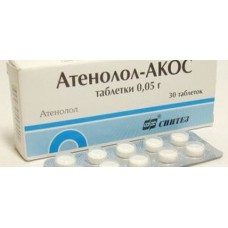Expiration date: 07/2026
The composition and form of issue
1 tablet contains atenolola 50, or 100 mg, in a contour acheikova packing 10 PCs., in a cardboard 3 bundle and 1 pack or in the banks dark glasses to 30 PCs and 50, paper cartons 1 Bank.
Pharmacological action
Antiarrhythmic, antihypertensive, antianginal.
Testimony
- Hypertension .
- Preventing attacks of angina (with the exception of strokes Prinzmetala).
Heart rhythm disorders:
- Sinus tachycardia.
- Prevention of supraventricular tachyarrhythmias.
- Ventricular premature beats.
Contraindications
AV blockade II and III extent, sinoatrialnaya blockade, SSSU, bradycardia, (heart rate less than 40 beats/min), hypotension (in the case of myocardial infarction, systolic BP less than 100 mm Hg.St.), cardiogenic shock, chronic heart failure IIB-III stage, acute heart failure, Prinzmetal's angina, lactation, the simultaneous admission of MAO inhibitors, hypersensitivity to atenolol.
Application of pregnancy and breastfeeding
Atenolol crosses the placental barrier, so use during pregnancy only if the expected benefit to the mother outweighs the potential risk to the fetus. Atenolol is excreted in breast milk, so if necessary, use during lactation is recommended to stop breastfeeding.
Method of application and doses
Inside, the food with liquid squeezed small amount of liquid. When arterial hypertension initial dose 50 mg 1 times a day (stable antihypertensive effect is achieved after 1-2 weeks). If necessary, increase the dose to 100 mg per 1 reception. Angina pectoris the initial dose — 50 mg 1 time a day, if necessary, increase the dose to 100-200 mg 1 times per day. Elderly patients with impaired kidney needed correction doses, in accordance with Cl creatinine: if Cl creatinine clearance is 10-30 ml/min prescribed 100 mg a day or 50 mg/day, less than 10 ml/min — 50 mg every day or 100 mg 1 once in 4 days, or on the background of hemodialysis 50 mg after each dialysis.
In elderly patients the initial single dose — 25 mg (increase under control blood pressure, heart rate).
Increasing the daily dose over 100 mg is not recommended because there has not been enhance the therapeutic effect, but increases the likelihood of side effects. Maximum daily dose of 200 mg. the Dose is reduced gradually — 1/4 of the dose every 3-4 days.
Side effects
Of the cardiovascular system: in some cases - bradycardia, hypotension, violations AV conduction, the appearance of symptoms of heart failure.
From the digestive system: at the beginning of therapy nausea, constipation, diarrhea, dry mouth.
CNS and peripheral nervous system: at the beginning of therapy possible fatigue, dizziness, depression, mild headache, sleep disturbances, feeling cold and paresthesias in the extremities, reduced reactivity of the patient, reduced secretion of tear fluid, conjunctivitis.
From the endocrine system: reduced potency, hypoglycemic state in patients with diabetes.
The respiratory system: in predisposed patients - onset of symptoms of bronchial obstruction.
Allergic reactions: skin itching.
Other: increased sweating, redness of the skin.
Special instructions
C caution should be used in diabetes, COPD (including asthma, emphysema), metabolic acidosis, hypoglycemia, allergic reactions in the anamnesis, chronic heart failure (compensated), obliterating peripheral arterial disease (intermittent claudication, Raynaud's syndrome), pheochromocytoma, liver failure, chronic renal insufficiency, myasthenia gravis, hyperthyroidism, depression (including in history), psoriasis, pregnancy, elderly patients, in Pediatrics (the efficacy and safety are not defined). In applying atenolola may decrease the production of tear fluid, which is important for patients who use contact lenses.
Drug interactions
While the use of diuretics is enhanced antihypertensive effect. With simultaneous use of means of inhalation narcosis increases the risk of increasing cardiodepressive actions and hypotension. There are reports of the development of bradycardia and arterial hypotension with concomitant use alkenone chloride. With simultaneous use of verapamil increases the negative inotropic effect, bradycardia develops, bradiaritmia expressed violations conductivity, described cases of postural hypotension, dizziness, left ventricular failure, lethargy. Under the influence of verapamil pharmacokinetic parameters of atenolol did not significantly change, although a case is described of increasing the AUC of atenolol.
Overdose
Symptoms: expressed aetiology, AV blockade II-III degree increase in symptoms of heart failure, excessive decrease in blood pressure, difficulty breathing, bronchospasm, dizziness, fainting, arrhythmia, ventricular arrythmia, cyanosis of nails of fingers or palms, seizures.
Treatment: gastric lavage and the appointment of absorbent medicines, with the occurrence of bronchospasm shown inhalation or intravenous beta 2 -agonists salbutamol.


